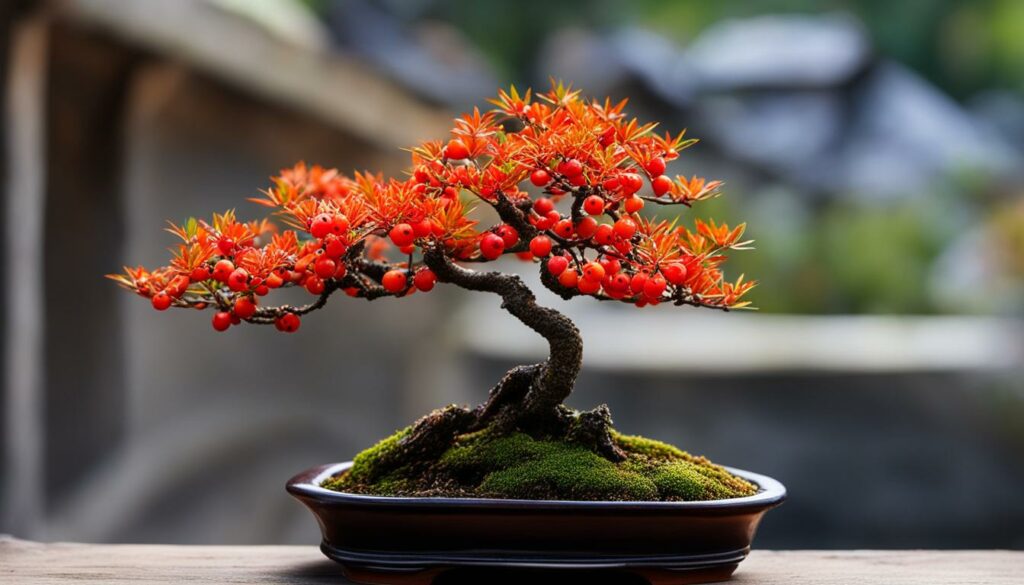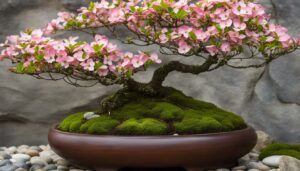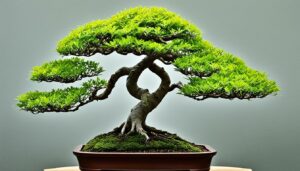If you’re new to bonsai or looking to expand your collection, Pyracantha bonsai is an excellent choice. This unique bonsai species, also known as the fiery Pyracantha, is renowned for its vibrant berry production and striking fiery appeal. With proper care, this tree can thrive in your home or garden, adding a touch of natural beauty and alluring charm.
In this section, we will explore the intriguing Pyracantha bonsai in more detail. We’ll cover everything from selecting the right tree to potting and repotting techniques, pruning and shaping tips, watering and fertilizing guidelines, and protecting your tree from pests and diseases. Whether you’re a seasoned bonsai enthusiast or a beginner, the following Pyracantha care tips will help you maintain a healthy and lively tree.
Key Takeaways
- Pyracantha bonsai is an excellent addition to any bonsai collection due to its unique berry production and fiery appeal.
- Proper care techniques, including tree selection, potting and repotting, pruning and shaping, watering and fertilizing, and pest and disease prevention, are crucial for maintaining a thriving Pyracantha bonsai.
- Understanding the ideal lighting conditions and temperature requirements is vital for promoting optimal growth and overall health of your bonsai tree.
- Displaying and showcasing your Pyracantha bonsai can enhance its beauty and provide a serene environment for relaxation and tranquility.
An Introduction to Pyracantha Bonsai
If you’re looking to add a unique and eye-catching bonsai to your collection, consider the Pyracantha bonsai. This species is also known as the firethorn bonsai due to its association with the firethorn plant. But what sets Pyracantha bonsai apart from other species is its stunning berries. Pyracantha is known as a berry-producing bonsai that adds vibrant color and visual interest to any display.
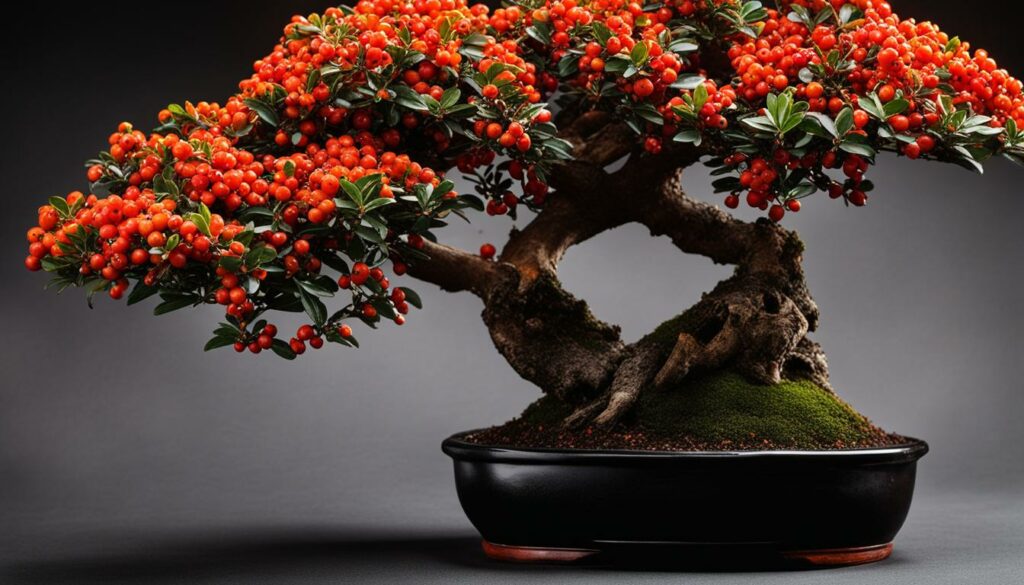
Pyracantha bonsai originated in China, where it was discovered as a wild plant. From there, it spread to other parts of the world, and eventually found its way into the world of bonsai. While Pyracantha bonsai can be somewhat challenging to care for, its unique beauty makes it a rewarding addition to any bonsai collection.
Selecting the Right Pyracantha Tree
Choosing the right Pyracantha tree is an essential step in bonsai cultivation. Here are some factors to consider when selecting a Pyracantha tree:
Tree Species
There are multiple Pyracantha species to choose from, each with unique characteristics. For bonsai cultivation, Pyracantha coccinea, also known as scarlet firethorn, is commonly preferred due to its smaller leaves and bright red berries.
Age
When selecting a Pyracantha tree, consider the tree’s age. A younger tree is easier to shape, but an older tree may have a more developed trunk and structure. It’s a matter of preference, but it’s important to keep in mind the time it takes for a bonsai to mature.
Overall Health and Vigor
Avoid selecting a Pyracantha tree with visible signs of disease, insect damage, or any other stress factors. A healthy and vigorous tree will have a strong root system and a good structure, making it easier to shape and maintain its health.
Keep in mind that the Pyracantha tree will be shaped and pruned repeatedly in the bonsai cultivation process, so it is essential to select a tree with enough structural integrity and potential for growth and development.
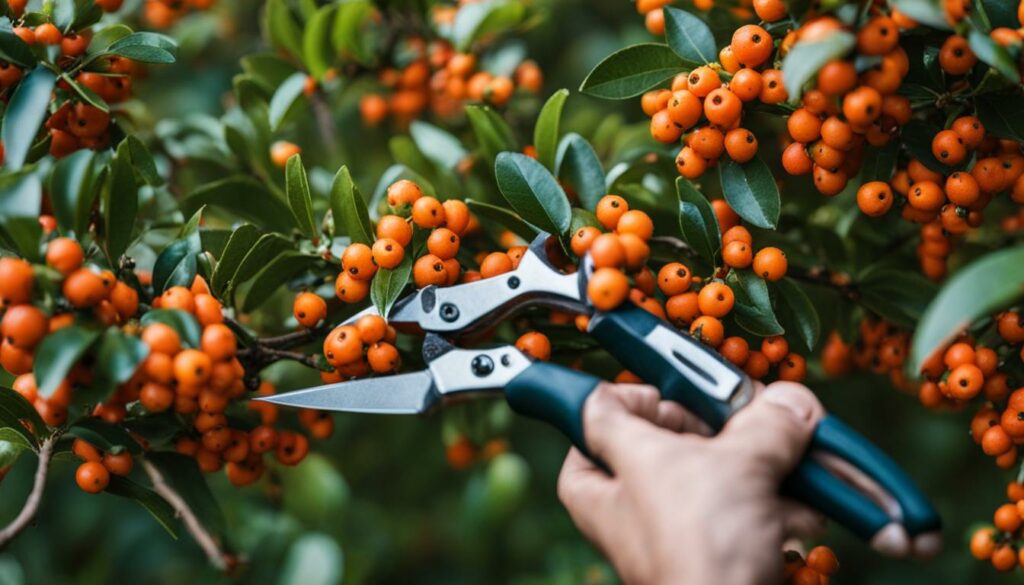
Tip: If you are unsure about selecting the right tree, seek advice from an experienced bonsai enthusiast or a reliable bonsai nursery.
Potting and Repotting Pyracantha Bonsai
Potting and repotting are fundamental practices that help maintain the health and well-being of your Pyracantha bonsai. However, it can be challenging to know when to repot your bonsai and the pot size and soil composition needed for optimal growth.
When to repot your Pyracantha bonsai: The best time to repot your Pyracantha bonsai is during the early spring season, just before the growth period begins. You should repot your bonsai every two to three years, depending on the tree’s age, size, and health.
The appropriate pot size: The ideal pot size for your Pyracantha bonsai should be slightly larger than the tree’s root ball, allowing for new roots to develop comfortably. However, avoid using pots that are too small or too large, as they can affect the tree’s growth and development.
Soil composition: The appropriate soil composition for your Pyracantha bonsai should be well-draining, with adequate nutrient content. A suitable soil mix for Pyracantha bonsai should consist of 60% inorganic material, such as pumice or volcanic rock, and 40% organic material, such as bark or peat moss.
Repotting procedure:
| Step | Description |
|---|---|
| Step 1 | Carefully remove the bonsai from its current pot, ensuring you do not damage the roots. |
| Step 2 | Trim the old roots and remove any soil from the root ball. |
| Step 3 | Place a layer of rocks or mesh at the bottom of the new pot to allow for drainage. |
| Step 4 | Add a layer of soil at the bottom of the pot, and position the bonsai on top. |
| Step 5 | Fill the pot with the soil mix and gently tap the pot to ensure the soil settles securely around the roots. |
| Step 6 | Water your Pyracantha bonsai thoroughly, ensuring the soil is well-moistened. |
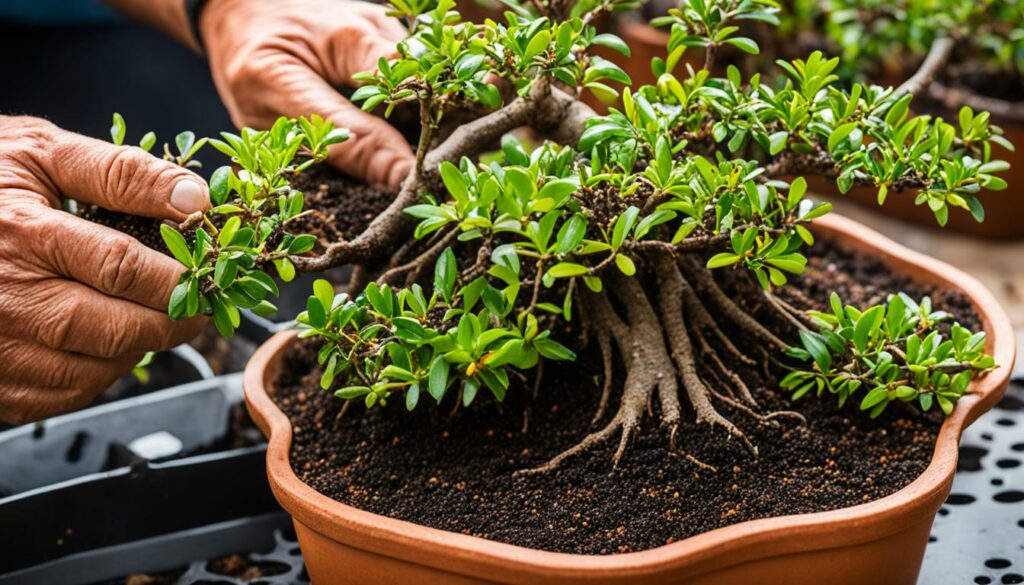
With these tips, you can optimize the growth and health of your Pyracantha bonsai and enjoy its vibrant beauty for years to come.
Pruning and Shaping Techniques
Proper pruning and shaping guarantee the healthy development of your Pyracantha bonsai trees. Regular pruning enhances the tree’s natural beauty by removing unwanted branches while stimulating new growth. Shaping helps to maintain the bonsai’s attractive structure as it grows.
Begin by inspecting the tree’s foliage and deciding which branches need trimming or cutting to shape the tree. Remember to focus on maintaining a balanced and harmonious shape. Pyracantha bonsai trees can benefit from pruning in the spring or fall, but avoid pruning in extreme temperatures.
Tip: Use sharp scissors or bonsai pruning shears to prevent damage to the tree. Remember to disinfect the blades after working on an infected tree to prevent the spread of disease.
Selective Pruning
Selective pruning involves cutting back overgrown, crossing, or diseased branches. This technique helps the tree to redirect its energy to new growth and prevent uneven or tangled branches. Start by identifying the branches to cut, then cut them at a 45-degree angle. Your tree will thank you for it!
Shaping Techniques
Shaping involves guiding the tree’s growth by trimming and directing specific branches to create a symmetrical and visually appealing structure. You may shape your Pyracantha bonsai by applying one of two techniques, namely:
| Technique | Description | Image |
|---|---|---|
| Pinching | This technique involves using your fingers to pinch off buds or branches that are not needed. Pinching stimulates the tree to develop new growth, creating a fuller and bushier tree. | 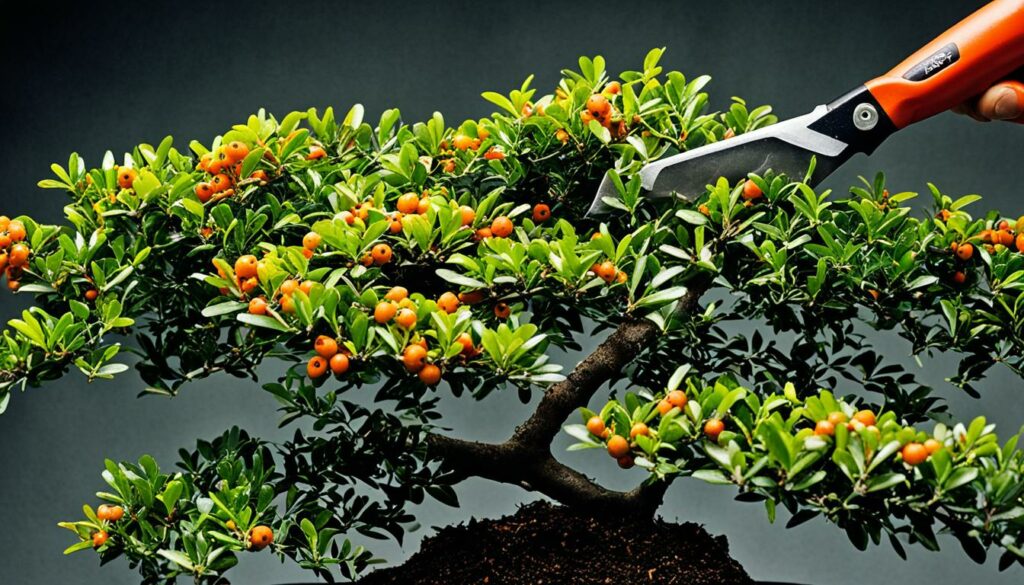 |
| Wiring | Wiring involves using wire to bend and shape the tree’s branches to achieve the desired structure. Be careful not to wrap the tree too tightly, as this could damage or scar the branches. Wire your Pyracantha bonsai while it’s still pliable, ideally in the spring or early summer. | 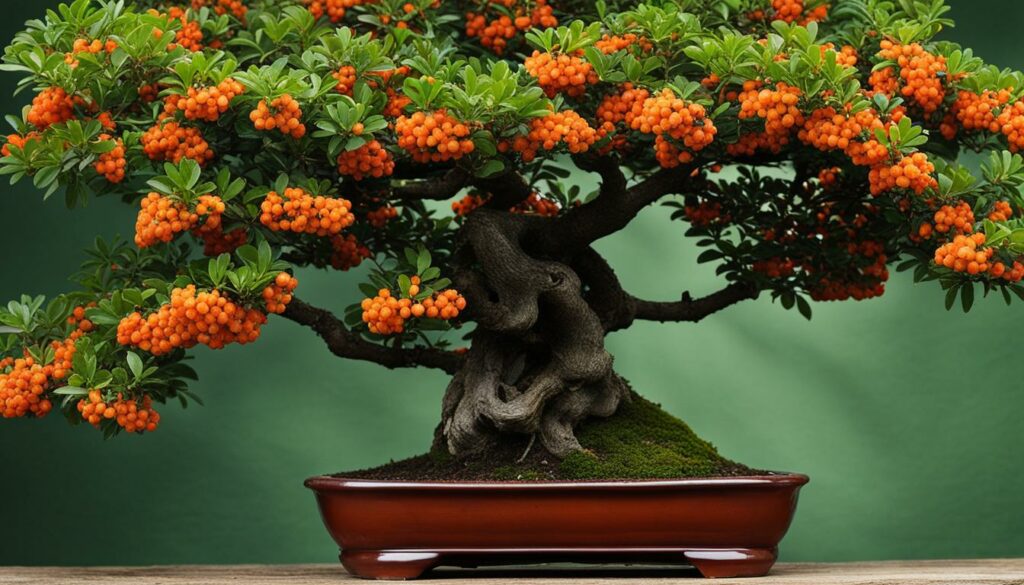 |
Note: Pyracantha bonsai trees are pliable and respond well to shaping techniques. However, they do not tolerate extreme or harsh techniques. Be gentle and patient to preserve your tree’s integrity.
Watering and Fertilizing Guidelines
Proper Pyracantha care requires appropriate watering and fertilizing. Here are some guidelines to ensure your bonsai thrives:
Watering Frequency
Watering frequency depends on various conditions, such as the relative humidity, temperature, and pot size. As a general rule of thumb, soak the tree until the water flows out of the container’s drainage holes. Repeat only when the soil is partially dry. Overwatering can cause root rot, while underwatering can lead to dried leaves and stunted growth.
Watering Techniques
Use a watering can with a fine rose nozzle to mist the leaves and branches occasionally. This technique mimics the effects of rainfall, ensuring adequate moisture reach the upper portions of the tree. Alternatively, you may submerge the entire pot into a basin of water until there are no air bubbles present.
Fertilizing Pyracantha Bonsai
| Fertilizing Type | When to Apply | Frequency |
|---|---|---|
| Organic Fertilizers | During the growing season | Every 4-6 weeks |
| Inorganic Fertilizers | Monthly | During the growing season |
For Pyracantha bonsai, use a balanced fertilizer with an equal proportion of nitrogen, phosphorus, and potassium. Organic fertilizers that contain fish emulsion, bone meal, cottonseed meal, and seaweed extracts are ideal. Additionally, you may use inorganic fertilizers such as slow-release granular or liquid fertilizers. Avoid fertilizing during the winter months when the plant is dormant.
Protecting Pyracantha Bonsai from Pests and Diseases
Pyracantha bonsai is prone to various pests and diseases that can damage its overall health and appearance. In this section, we will highlight some common issues and provide valuable insights on how to protect your Pyracantha bonsai.
Identifying Pests
One of the most critical steps in protecting your Pyracantha bonsai is identifying common pests. Spider mites, scale insects, and mealybugs are among the most common pests that affect Pyracantha bonsai. Spider mites are tiny arachnids that feed on the tree sap and damage the foliage. Scale insects are oval-shaped pests that appear as tiny bumps on the bark. They feed on the tree sap and excrete a sticky substance known as honeydew. Mealybugs are soft-bodied pests that secrete a white powdery substance and feed on the tree’s sap.
To identify these pests, you should regularly inspect your Pyracantha bonsai for signs of damage. Look for yellowing or browning leaves, distorted growth, and a sticky residue on the branches and foliage.
Preventing and Treating Pest Infestations
Preventing and treating pest infestations is essential to keep your Pyracantha bonsai healthy. Regularly remove dead branches, leaves, and debris around the tree to discourage pest growth.
You can also prevent pests by keeping your bonsai in optimal conditions. Ensure the tree receives adequate sunlight, and you are following proper watering and fertilizing guidelines (as discussed in previous sections).
If you notice signs of pest infestation, you should act quickly to prevent further damage. Isolate the tree from other plants to prevent the spread of pests and use proper techniques to treat the infestation. Insecticidal soaps, horticultural oils, and neem oil are effective treatments for pests such as spider mites and mealybugs.
Common Diseases
Aside from pests, Pyracantha bonsai is also prone to various diseases that can damage its growth. Fire blight, root rot, and fungal infections are among the most common diseases that affect Pyracantha bonsai. Fire blight is a bacterial infection that causes the leaves and branches to turn black. Root rot is a fungal infection that affects the roots and causes the tree to wilt. Fungal infections can cause discolored growth and decay.
Preventing and Treating Diseases
Preventing and treating diseases involve maintaining proper care for your Pyracantha bonsai and monitoring it for signs of disease. Avoid overwatering your bonsai, as this can lead to root rot. You should also regularly remove dead or diseased branches and leaves.
If you notice signs of disease, promptly isolate the tree from other plants and prune off any affected areas. Fungicides can often treat fungal diseases, and bacterial infections such as fire blight may require the use of copper-based solutions.
By following proper Pyracantha care and taking proactive measures to protect your bonsai from pests and diseases, you can enjoy a beautiful and thriving fiery Pyracantha bonsai for years to come.
The Importance of Sunlight and Temperature
Successful Pyracantha care requires appropriate attention to sunlight and temperature, which are crucial factors that contribute to the tree’s overall health and growth. Pyracantha bonsai is sensitive to both excesses and deficiencies in these areas.
Firstly, consider the lighting conditions required for your Pyracantha bonsai. As a general rule, these trees thrive in full sun or partial shade, requiring a minimum of six hours of direct sunlight per day. However, it’s essential to place your bonsai tree in a well-ventilated spot, protected from harsh, direct sunlight and strong winds.
Secondly, temperature plays a significant role in Pyracantha care as it is sensitive to cold and frost. Pyracantha bonsai trees prefer moderate temperatures ranging from 50 to 70°F (10 to 21°C). During the winter season, it is best to keep your Pyracantha bonsai tree indoors to protect it from frost and freezing.
Remember to monitor the lighting conditions and temperature consistently to ensure adequate Pyracantha care and growth. Consider placing a thermometer near your bonsai tree to track temperature changes regularly.
In the next section, we will discuss various tips on how to display and enjoy your stunning Pyracantha bonsai.
Displaying and Enjoying Your Pyracantha Bonsai
After investing time and effort in cultivating your Pyracantha bonsai, it’s time to showcase it in a way that helps you appreciate its fiery appeal while adding beauty to your surroundings. Here are some tips for displaying and enjoying your Pyracantha bonsai:
Indoor vs. Outdoor Display
Deciding where to display your Pyracantha bonsai is crucial for its growth and overall well-being. If you plan to keep it indoors, ensure that it receives enough sunlight and fresh air. Place it near a south-facing window or under a grow light to provide the ideal lighting conditions. On the other hand, if you choose to display it outdoors, select a spot that receives partial sunlight and is protected from strong winds and extreme temperatures.
Harmonious Display Location
Creating a harmonious display location for your Pyracantha bonsai is essential to promote relaxation and tranquility. Choose a location that is visually appealing and provides an excellent backdrop for your bonsai’s color and texture. You can also consider adding complementary plants, rocks, or other decorative elements to create an eye-catching display.
Container Selection
The container you choose for your Pyracantha bonsai can significantly impact its visual appeal. Select a pot that is large enough to accommodate the tree’s roots and has drainage holes to prevent waterlogging. You can also choose a container that complements the tree’s overall aesthetic and serves as a decorative element on its own.
Regular Maintenance
Maintaining your Pyracantha bonsai is crucial to ensure its longevity and beauty. Regularly inspect the tree for signs of pests or disease and take appropriate measures to address any issues promptly. Water and fertilize the tree as required and prune it to maintain its shape and structure. Regular maintenance will help you enjoy your Pyracantha bonsai for years to come.
By following these guidelines, you can display and enjoy your Pyracantha bonsai while ensuring its optimal growth and overall health. Remember, with proper care and attention, your Pyracantha bonsai can serve as a beautiful addition to your home or garden.
FAQ
What is Pyracantha bonsai?
Pyracantha bonsai is a miniature tree cultivated from the Pyracantha species, also known as firethorn. It is a popular bonsai choice due to its vibrant foliage, stunning berries, and ability to thrive in a compact form.
How do I select the right Pyracantha tree for bonsai cultivation?
When selecting a Pyracantha tree for bonsai cultivation, consider factors such as tree species, age, and overall health. Look for a well-developed trunk, balanced branches, and healthy foliage to ensure a strong foundation for your bonsai journey.
What is the potting and repotting process for Pyracantha bonsai?
For potting and repotting Pyracantha bonsai, use an appropriate pot size and well-draining soil mixture. Repotting is usually done every two to three years to maintain the tree’s health and promote optimal growth.
Are there any specific pruning and shaping techniques for Pyracantha bonsai?
Yes, to enhance the fiery appeal of Pyracantha bonsai, selectively prune branches to maintain its desired shape. You can also shape the foliage by wiring the branches and maintaining an attractive structure.
How often should I water and fertilize my Pyracantha bonsai?
The watering frequency of Pyracantha bonsai depends on factors such as climate and soil composition. Generally, water when the soil starts to feel slightly dry. As for fertilizing, apply a balanced bonsai fertilizer every four to six weeks during the growing season.
How can I protect my Pyracantha bonsai from pests and diseases?
To protect Pyracantha bonsai from pests and diseases, regularly inspect the tree for signs of infestation or infection. Treat any issues promptly with appropriate pesticides or fungicides. Additionally, maintain good hygiene by removing fallen leaves and debris from the soil surface.
What are the sunlight and temperature requirements for Pyracantha bonsai?
Pyracantha bonsai thrives in full sun to partial shade conditions. Provide it with at least four to six hours of direct sunlight daily. Regarding temperature, it prefers a moderate climate with temperatures ranging between 50°F and 80°F (10°C to 27°C).
Can I display my Pyracantha bonsai indoors?
While Pyracantha bonsai can be displayed indoors, it’s important to provide it with adequate sunlight and ensure proper air circulation. Consider placing it near a well-lit window or using artificial grow lights to simulate natural light conditions.
How can I create a harmonious bonsai environment for my Pyracantha?
To create a harmonious bonsai environment, choose a suitable indoor or outdoor location with proper lighting and airflow. Place your Pyracantha bonsai in an area that promotes relaxation and tranquility, such as a garden or a well-designed indoor display area.
